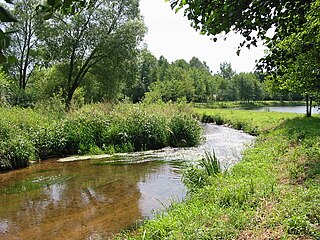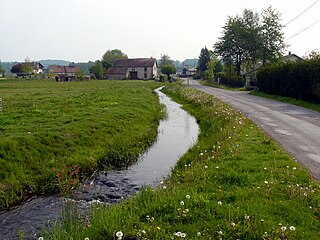
The Meurthe is a river in north-eastern France, right tributary to the river Moselle. It is 161 km (100 mi) long. Its source is in the Vosges mountains, near the Col de la Schlucht in the Vosges département, from where it flows in an overall north-westerly direction. Its name gave rise to the naming of the present French département Meurthe-et-Moselle and the former département Meurthe.

The Orne is a river in Grand Est, north-eastern France, which is a left tributary of the Moselle and sub-tributary of the Rhine. Its source is in the hills northeast of Verdun. It flows east and joins the Moselle near Mondelange, between Metz and Thionville.

The arrondissement of Saint-Dié-des-Vosges is an arrondissement of France in the Vosges department in the Grand Est région. It has 96 communes. Its population is 111,750 (2016), and its area is 1,458.2 km2 (563.0 sq mi).

Neuvillers-sur-Fave is a commune in the Vosges department in Grand Est in northeastern France.

Provenchères-sur-Fave is a former commune in the Vosges department in northeastern France. On 1 January 2016, it was merged into the new commune Provenchères-et-Colroy. Inhabitants are called Provenchérois. Provenchères-sur-Fave should not be confused with Provenchères-lès-Darney in the same department.

The Vologne is a river of the Vosges department in France. It is a right tributary of the Moselle. Its source is in the Vosges Mountains, on the northwestern slope of the Hohneck. It flows through the lakes of Retournemer and Longemer, and passes the villages of Xonrupt-Longemer, Granges-sur-Vologne, Lépanges-sur-Vologne and Docelles, finally flowing into the Moselle in Pouxeux.
The Association of Fave and Meurthe communes is a former administrative association of communes in the Vosges département of eastern France and in the region of Lorraine. It was created in December 1997. It was merged into the Communauté de communes Fave, Meurthe, Galilée in January 2014, which was merged into the new Communauté d'agglomération de Saint-Dié-des-Vosges in January 2017. The association had its administrative offices at Remomeix. It takes its name from the rivers Fave and Meurthe which flow across it.
The Association of Galilée Valley communes is a former administrative association of communes in the Vosges département of eastern France and in the region of Lorraine. It was created in December 1997. It was merged into the Communauté de communes Fave, Meurthe, Galilée in January 2014, which was merged into the new Communauté d'agglomération de Saint-Dié-des-Vosges in January 2017. Positioned 15 minutes to the east of Saint-Dié-des-Vosges, bordering the ridge that forms the mountainous frontier between Alsace and Lorraine, the association has its administrative offices at Ban-de-Laveline. Seven of the association's ten communes are within the Ballons des Vosges Nature Park.
The Canton of Provenchères-sur-Fave is a former French administrative and electoral grouping of communes in the Vosges département of eastern France and in the region of Lorraine. It was disbanded following the French canton reorganisation which came into effect in March 2015. It consisted of 7 communes, which joined the canton of Saint-Dié-des-Vosges-2 in 2015. It had 2,417 inhabitants (2012).
The Communauté de communes de la Fave is a French former administrative association of rural communes in the Vosges département of eastern France and in the region of Lorraine. It was created in December 1994 and had its administrative offices at Provenchères-sur-Fave. It was merged into the Communauté de communes Fave, Meurthe, Galilée in January 2014, which was merged into the new Communauté d'agglomération de Saint-Dié-des-Vosges in January 2017. It takes its name from the little river Fave.

The Mortagne is a 74.6-kilometre (46.4 mi) long river in the Vosges and Meurthe-et-Moselle départements, northeastern France. Its source is at Saint-Léonard, 5 km (3.1 mi) west of the village, in the Vosges Mountains. It flows generally northwest. It is a left tributary of the Meurthe into which it flows at Mont-sur-Meurthe, 5 km (3.1 mi) southwest of Lunéville.

The Neuné is a river which flows in the Vosges department of France. It is a right tributary of the Vologne, and therefore a sub-tributary of the Moselle. It is 24.5 km (15.2 mi) long.

The Cleurie or rupt de Cleurie is a river in Lorraine in France, which flows in the Vosges department. It is a right tributary of the Moselotte, and thus a sub-tributary of the Rhine, via the Moselotte and the Moselle. It is 18.9 km (11.7 mi) long.

The Moselotte is a river in Lorraine, in the French department of Vosges. It is a direct right tributary of the Moselle, and thus a sub-tributary of the Rhine.
The Xoulces is a small but abundant river in France which flows in Lorraine in the Vosges department. It is a left tributary of the Moselotte, and thus a sub-tributary of the Rhine via the Moselotte and the Moselle. It is 9.4 km (5.8 mi) long.

For people with the surname, see Bouchot (surname).

The Lanterne is a river in the east of France, a substantial left tributary of the Saône, and sub-tributary of the Rhône. It is 64.3 km (40.0 mi) long.
The Aulnois is a Franco-Belgian river which flows in the French Ardennes département and in the province of Luxembourg in the far south of Belgian Wallonia. It is about 18 km (11 mi) long, of which 7 km in France. It is a fairly fast-flowing right tributary of the Chiers.
The Communauté d'agglomération de Saint-Dié-des-Vosges is an administrative association of communes in the Vosges and Meurthe-et-Moselle departments of eastern France. It was created on 1 January 2017 by the merger of the former Communauté de communes de Saint-Dié-des-Vosges, Communauté de communes de la Vallée de la Plaine, Communauté de communes des Hauts Champs, Communauté de communes du Pays des Abbayes, Communauté de communes du Val de Neuné and Communauté de communes de la Fave, Meurthe, Galilée. On 1 January 2018 it gained 3 communes from the Communauté de communes Bruyères - Vallons des Vosges. It consists of 77 communes, and has its administrative offices at Saint-Dié-des-Vosges. Its area is 979.9 km2. Its population was 74,926 in 2018, of which 19,724 in Saint-Dié-des-Vosges proper.

The canton of Saint-Dié-des-Vosges-2 is an administrative division of the Vosges department, in northeastern France. It was created at the French canton reorganisation which came into effect in March 2015. Its seat is in Saint-Dié-des-Vosges.
















